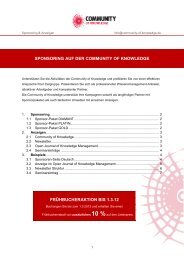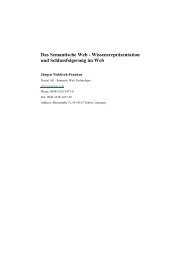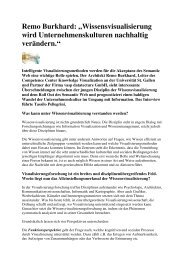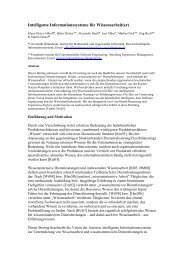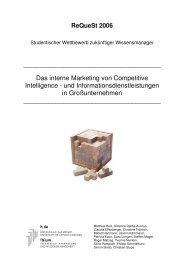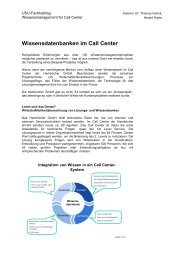OPEN JOURNAL OF KNOWLEDGE MANAGEMENT ...
OPEN JOURNAL OF KNOWLEDGE MANAGEMENT ...
OPEN JOURNAL OF KNOWLEDGE MANAGEMENT ...
Sie wollen auch ein ePaper? Erhöhen Sie die Reichweite Ihrer Titel.
YUMPU macht aus Druck-PDFs automatisch weboptimierte ePaper, die Google liebt.
Another advantage of Social forecasting was its speed. Collecting the knowledge from employees<br />
required only about 1 week while results from surveys and test sales came in only after 4 weeks.<br />
Tests had to be launched well in advance in order to be available on time. Social Forecasting<br />
added significant flexibility here.<br />
From a single product-perspective the cost of evaluating a new product by Social Forecasting<br />
were 90% lower than those of the existing forecasting process. This extreme cost shift is possible<br />
because drawing on the existing knowledge of employees is practically for free, while the cost of<br />
representative surveys and test sales is quite high.<br />
Conclusion<br />
Forecasting new products is hard. There is no past data to use in statistical models, consumer surveys<br />
and test sales are expensive. In such a situation a Collective Intelligence-based approach like<br />
Social Forecasting was able to provide high-quality forecasts at extremely low cost.<br />
The performance of Social Forecasting was well received by the project team and warranted the<br />
regular use of Social Forecasting at Tchibo. This new forecasting process would not completely<br />
replace traditional market research and test sales but only part of them in order to combine the<br />
strengths of both approaches while saving forecasting costs on less important products. Tchibo decided<br />
to use Social Forecasting primarily on its high-selling products. These products required the<br />
same forecasting effort as any other product but had a much higher ROI on forecasting accuracy.<br />
The total annual cost savings from replacing part of the surveys and test sales with Social Forecasting<br />
were in the range of single-digit million Euro figures. The additional EBIT benefits from<br />
higher forecasting accuracy are not discloseable.<br />
An added bonus of Social Forecasting was less tangible: Shop managers and warehouse workers<br />
were very happy. The feeling of one’s own opinion mattering to HQ was boosting staff morale<br />
and triggered even more feedback and new product ideas from employees. While these are quite<br />
remarkable side effects they are beyond the scope of this case study which focused on the measurable<br />
benefits of sourcing employee knowledge with a new and innovative approach.<br />
References<br />
Open Journal of Knowledge Management<br />
Armstrong, J.Scott (2001): Principles of Forecasting, Springer Press, New York, p. 682<br />
Ausgabe V/2012 Seite 31<br />
Ivanov, A. (2011): Sales Forecasts without Market Research: How does it work?, Controller Magazin, September/October<br />
2011<br />
Preller, G; Rudzinski, C. (2009): Ich sehe was, was du nicht siehst: Informationsmärkte analysiert anhand<br />
eines filialisierten Einzelhändlers, in Aulinger, A.; Pfeiffer, M (ed.) (2009): Kollektive Intelligenz. Methoden,<br />
Erfahrungen und Perspektiven, Steinbeis-Edition, Stuttgart/Berlin, p. 151-176



